Karl Baron of Urban | |
|---|---|
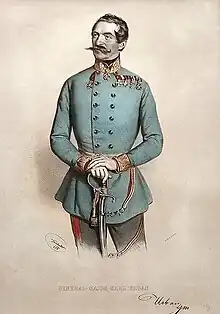 Karl von Urban in 1850 by Kriehuber | |
| Native name | Karl Freiherr von Urban |
| Born | 31 August 1802 Kraków, Kingdom of Galicia and Lodomeria, Austrian Empire |
| Died | 1 January 1877 Brünn, Margraviate of Moravia, Austria-Hungary |
| Allegiance | |
| Service/ | Imperial and Royal Army |
| Years of service | 1815-1865 |
| Rank | Feldmarschall-leutnant (Field Marshal-Lieutenant) |
| Commands held |
|
| Battles/wars | Revolution in Sardinia-Piedmont
Revolutionary War of 1848-1849
Second Italian War of Independence
|
Karl (Carl) Freiherr von Urban (English: Karl Baron of Urban; born 31 August 1802 in Kraków - died 1 January 1877 in Brünn) was an Austrian Feldmarschall-leutnant celebrated for his daring tactics of lightning surprise attacks, often against much larger forces, which earned him the epithet of Austrian Garibaldi.[1] He is particularly distinguished for his decisive actions during the Revolutionary Wars of 1848-1949 and his participation in the Second Italian War of Independence. Von Urban was the first commander to make a stand against the Revolution in Hungary, organizing the resistance and defending minorities.[2] On 18 November 1848 he defeated the insurgents at Klausenburg and liberated the capital of the easternmost province of the Empire.[3]
Early Years and Baptism of Fire
Karl von Urban was born in Cracovia, at the time part of the Austrian Empire, to a Sudeten German family of officers who served the Imperial Army. He received his education at the Cadet Academy of Olmütz (Olomouc) and, on 1 November 1815, he enrolled in the Imperial and Royal Army,[4] being assigned to the 29th Infantry Regiment.[5]
When the Revolution erupted in the Kingdom of Sardinia-Piedmont in 1821, the Quintuple Alliance, meeting at the Congress of Laibach, decided to intervene to restore the legitimate government. At the time a young cadet corporal,[5] Urban was selected to integrate the Austrian expeditionary force sent in the name of the Holy Alliance and underwent his baptism of fire at the Battle of Novara on 8 April.
Ascension in the military career
After Novara, Urban's progress in the ranks of the Imperial and Royal Army was meteoric and he performed a variety of prestigious roles, thanks in particular to his solid knowledge and exceptional adaptability.[5] He was promoted to Ensign in 1823 and in 1828, upon his appointment as Second Lieutenant, he was transferred to the 59th Infantry Regiment, where he served until his promotion to Major and assignment to the 13th Border Infantry Regiment in 1844.[4]
From 1828 to 1835, Urban served as the Adjutant to the Military Command and Government in Moravia and Silesia. He then took up the position of head and instructor at the Regimental Cadet School,[6] where he shared many of the new ideas of war of movement and reform of the army with Radetzky.
In the years of 1837 to 1839, he participated in the military survey of the Inn Valley[5] and, from 1843, Urban served in the General Command of the province of Banat. In 1845, he was named the General-Command Adjutant in the Military Government of the same province, a position he served for two years.[6]
In 1847, Urban was promoted to Lieutenant Colonel and was soon transferred to the 2nd Romanian Border Regiment in the Principality of Transylvania. It was in this position that he found himself caught up by the Revolutionary storm that soon spread to Hungary and across the Austrian Empire during the fateful month of March 1848.[6]
Revolutionary War of 1848-1849
A staunch defender of the Habsburg cause and of the ethnic minorities oppressed by the Revolution, Urban was the first military commander to make a stand against the Revolution.[3] He opened a second front on the rearguard of the Revolutionary forces and his actions were strategic to boost the morale of the Imperial camp and to the ultimate defeat of the Revolution, which threatened the very existence of the Austrian Empire.
Leader of the Resistance: the Assembly and Memorandum of September 10
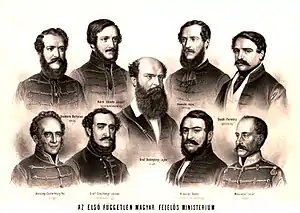
During the mobilization of the first battalion of his regiment, he publicly addressed the soldiers in Romanian, their native language, exhorting them to remain faithful to the Imperial House, their oath and their colors. He urged them to steadfastly refuse to swear allegiance to the April Laws, regardless of the Hungarian ministry's directives,[6] which obliged every military personnel to swear loyalty to the Revolution.
On September 10, Urban summoned leaders of all 44 districts of the Principality to his headquarters in Naszód (Năsăud). Then he disavowed the Hungarian Ministry of War in a Memorandum[6] and offered protection both to villages that rejected conscription and to the landowners who feared a peasant rising. Finally he administered the oath of allegiance to the hundreds of peasants and village delegates.[7]
Urban acted in such a compelling manner that, by the end of September, 918 communities in the region had distanced themselves from the Revolution and were won over to the imperial and counter-revolutionary cause. This dealt a fatal blow to the power of the revolutionary party.[6]
Champion of the minorities and Strategic Commander
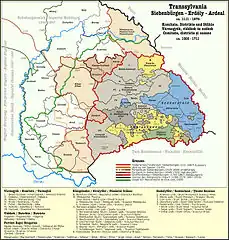
Tensions between the Romanian population and the Hungarian government were exacerbated by the refusal of the Hungarian Revolutionary government to grant equal rights to the Romanian and German minorities, by the decision to annex the Principality into Hungary and by the imposition of forced conscription into the Revolutionary Army. Above all, the minorities were exasperated by the summary executions and massacres of Romanians during the summer and autumn by Revolutionary tribunals and units on the orders of the government in Pest, mostly for refusing forced conscription.[8]
Without communication with the General Command in Vienna and operating without funds, provisions or directives, Urban organized the Romanian national militia and prepared his small force of Grenz Infantry for the herculean challenge of fighting the Revolution.[6]
Finally, in October 1848, Lieutenant-Colonel Urban was appointed as the strategic Commander in northern Transylvania with the caveat to "trust himself and his judgment." This was despite the presence of six higher-ranking generals in the region.[6] Simultaneously, he moved with his troops to Sächsisch Regen (Szászrégen/ Reghin), in order to attract the entire strength of the Revolutionary Army assembled at Vásárhely and enable the troops in the southern part of Transylvania to concentrate and procure war materials.[5]
Revolutionary War and the Liberation of Klausenburg
Skirmishes between the revolutionary National Guard and the Austrian troops under Von Urban had already commenced when the war against the Hungarian revolutionary government was officially declared.[6] The hostilities started after the assassination in Pest of Count von Lamberg, appointed by Vienna as military commander and palatine for Hungary, by a mob of revolutionaries on 28 October 1848.
Battles of Voivodeni Dej and Gherla

Despite being vastly outnumbered, the intrepid Von Urban was determined to fight. On 31 October 1848, he faced with his 1.200 men the revolutionary National Guard, numbered over 12.000 and formed mostly by Szeklers, in a heated reconnaissance engagement at Voivodeni (Vajdaszentivány/Johannisdorf). Following the encounter, Urban withdrew to Wallendorf to await for reinforcements by the Wardener Brigade.[6]
With the joint forces of his Romanian Infantry Regiment and the Wardener Brigade, Urban considered himself ready to go on the offensive. After conquering Dej (Dés/Desch) for the first time on November 10 and occupying Gherla (Szamosújvár/Neuschloss) on November 11, he enticed the Hungarian army from their strongholds with a bold and unexpected maneuver.
At the Battle of Gherla that followed on 13 November 1848, Karl von Urban, with his small force of around 3.000, engaged the 12.000-strong National Guard led by Manó Baldacci, the Hungarian commander-in-chief in Transylvania.[7] He completely routed them, winning a brilliant victory.[6]
Liberation of Klausenburg
With this success at Gherla, Karl von Urban prepared to liberate Klausenburg (Cluj-Napoca/Kolozsvár), the Capital of the Principality of Transylvania. He reached Apahida (Bruckendorf) on November 15, which he would use as bridgehead to launch the attack.
The Hungarian position was highly advantageous, requiring Urban's columns to storm through the town on a narrow road while enduring heavy crossfire. At one point, they even seemed to be faltering, but Urban pressed for a renewed attack, which was ultimately successful.[6] On November 18, Klausenburg was liberated by Von Urban.[5][3][7]

The Second Battle of Dej
Meanwhile, the revolutionaries had once again advanced on Dej (Dés/Desch), displacing the Austrian troops there. Katona Miklós, who held the town, probably did not anticipate an attack from Urban and his single regular brigade. However, the Austrian Lieutenant Colonel held a different opinion. In a war council in Klausenburg, he offered to retake the city.
At the Battle of Dej on November 24, he launched a storming attack from two flanks with his 1.500 men against 10.000 strong enemy armed with 16 cannons, allowing Katona barely enough time to fire a few of his cannons. During this engagement, Urban's cavalry charged into the ranks of the insurgents, plunging them into great disarray. They fled into the mountains, pursued by Urban for seven hours.[6]
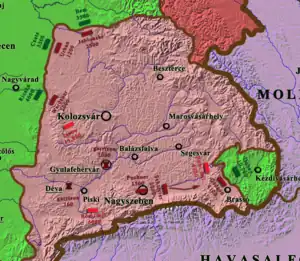
Interwar Period
Upon the conclusion of the campaign in Hungary, Urban served as the Military District Commander of Transylvania for over a year, with his headquarters in Klausenburg,[6] the city he had liberated two times.
On June 1850 he was promoted to Major General.[4]
He distinguished himself as the military district commander by energetically countering the excesses of marauding rebel bands and saved Dej, Gherla, and Klausenburg from the threat of destruction. For these actions of valour, the citizens of Klausenburg granted him the Honorary Citizenship, in recognition of his efforts to save their city.[6]
In November 1853, he was appointed as the Adlatus to the Gendarmerie Commander,[5] where he served for almost four years.
Von Urban was promoted to Feldmarschall-leutnant (Field Marshal-Lieutenant) on September 1857,[4] becoming a division commander in the 7th Army Corps.[6]
Second Italian War of Independence 1959
During the Italian Campaign of 1859, Von Urban commanded the IX. Army Corps, an independent mobile division also known as Division Urban, and was responsible for the only Austrian victories in this war. In no less than four occasions the Austrian Garibaldi fought against the Italian Garibaldi, resulting in a draw of two victories for each commander.
Battle of Montebello
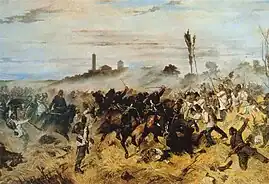
In the reconnaissance Battle of Montebello on May 20, the first in the conflict, Karl von Urban faced the French and Sardinian Armies. Despite being outnumbered in men and firepower, Urban managed to resist the enemy's assaults for almost the entire day, only retreating with the arrival of the Sardinian Cavalry.
For his valour and great ability displayed during this battle, Karl von Urban was distinguished with the highest honour, with the expression of the utmost satisfaction by the Emperor Franz Joseph, conveyed to him on June 2.[6]
Battles of Varese and San Fermo
After Montebello, Urban was sent by Ferenc Gyulay to check Garibaldis Alpine Hunters on the Austrian right flank[9] and, due to the Franco-Sardinian advance after the Battle of Magenta and the defeats at the Battle of Varese and San Fermo, Von Urban retreated to the Mincio and was changed to defend the rearguard of the retreating Austrian Army. Urban eluded the threat to his flank by conducting a forced march and successfully reached the Mincio through arduous and bloody rear-guard actions.[6]
Battle of Treponti and Commander of Verona
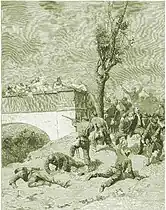
At the Battle of Treponti on June 15, Von Urban defeated Garibaldi, who was pursuing the Austrians.
After Treponti, Von Urban was appointed supreme commander over Verona,[3] the Imperial Headquarters and main fortress of the Quadrilateral, the Austrian strategic defensive system in Italy.
Following the Battle of Solferino and the Peace of Villafranca, Karl von Urban was assigned commander of the 4. Army Corps in Brünn, Bohemia.[6] On February 1862, he was commissioned to the Military General Command for Moravia and Silesia, a post he held until his retirement on 1 May 1865.[5]
Von Urban took his own life on 1 January 1877 in Brünn.
Honours
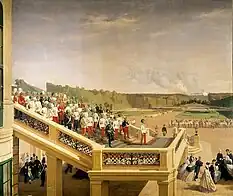
Austrian and Hungarian Awards
- Knight of the Military Order of Maria Theresa
- Knight of the Austrian Imperial Order of Leopold with war decoration
- Knight of the Royal Hungarian Order of Saint Stephen
- Officer's Service Badge 1st Class
Foreign Awards
Bavarian
Russian
- Knight Grand Cross of the Order of St. Stanislaus 1st Class
- Knight of the Imperial Order of Saint Prince Vladimir with Swords
- Knight of the Order of St. Anne with Crown and Swords
- Knight of the Imperial Order of Saint Alexander Nevsky
Sources
- ↑ Trevelyan, G. M. (2022). Garibaldi and the Thousand (1st: reprint of the original, 1909 ed.). Frankfurt: Salzwasser Verlag GmbH. p. 108. ISBN 978-3-37509-585-7.
- ↑ Kühne, Ferdinand Gustav (1859). Europa: Chronik der gebildeten Welt, Issues 27-52. Leipzig.
{{cite book}}: CS1 maint: location missing publisher (link) - 1 2 3 4 Meyer, Herrmann Julius (1867). Neues Konversations-Lexikon. Hildburghausen.
{{cite book}}: CS1 maint: location missing publisher (link) - 1 2 3 4 GRUNDBUCHBLATT – ABSCHRIFT: Karl Freiherr von Urban (Service Record - Transcript)
- 1 2 3 4 5 6 7 8 Pallua-Gall, Julian (1895). Urban, Karl Freiherr von. In: Allgemeine Deutsche Biographie - ADB (Universal German Biography). Band 39 (in German). Leipzig: Duncker & Humblot. pp. 349–351.
- 1 2 3 4 5 6 7 8 9 10 11 12 13 14 15 16 17 18 19 von Wurzbach, Constantin (1884). Urban, Karl Freiherr. In: Biographisches Lexikon des Kaiserthums Oesterreich (Biographical Encyclopedia of the Austrian Empire) (in German). Wien: Kaiserlich-königliche Hof- und Staatsdruckerei. pp. 116–123.
- 1 2 3 Miskolczy, Ambrus (2002). Transylvania in the Revolution and the War of Independence (1848-1849) in History of Transylvania Vol. III. Institute of History of the Hungarian Academy of Science. ISBN 0-88033-497-5.
- ↑ Seton-Watson, R. W. (1934). A History of the Roumanians: From Roman Times to the Completion of Unity. Cambridge: Cambridge University Press. p. 292.
- ↑ Lance, Adolphus (1859). The History Of Italy From The Fall Of Venice, Up To The Eve Of The Renewed Struggle In Mdccclix. London.
{{cite book}}: CS1 maint: location missing publisher (link)